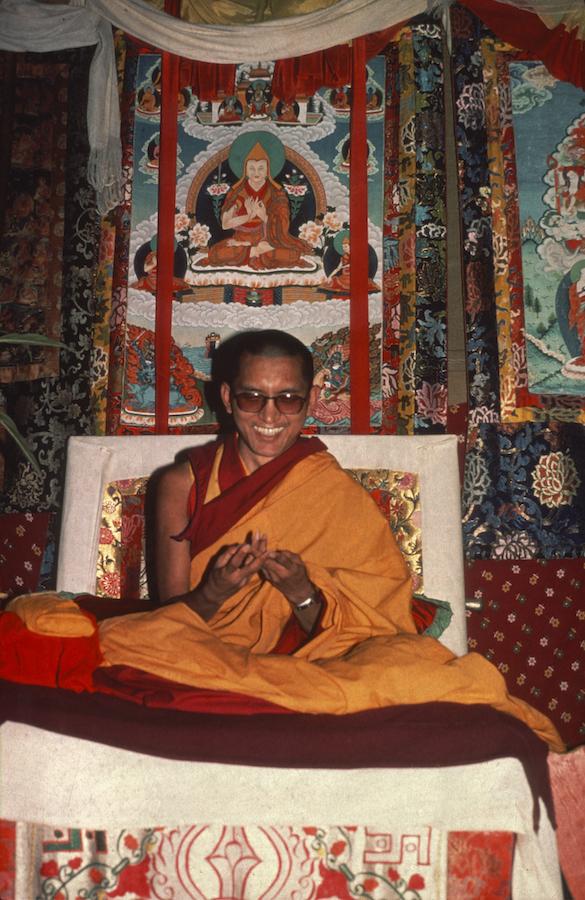First you should have the foundation in mind. In order to enter the Tantrayana path you need to receive an initiation. To enter the Highest Yoga Tantra path, Maha-anuttara Tantra, you must receive an initiation into the Maha-anuttara Tantra path. To be granted the initiation it is desirable that the mind should be enriched in the three principal aspects of the path: the thought to renounce samsara, bodhicitta and the wisdom realizing emptiness. A mind that has these fundamental realizations is the perfect receptacle for the initiation.
In order to generate the thought of renouncing samsara, you first have to cut off clinging to this life, seeing the works of this life as just like food you have vomited out. To renounce samsara, you should see the whole of samsara is like being in the middle of a nest of poisonous snakes or like living in a thorn bush. Wherever you stay there is not one single happiness; that is the nature of samara. Wherever you stay it’s like a being in big hole full of thorns, so that wherever you move your body there is only pain. You must see the whole of samsara as in the nature of suffering and have not the slightest attraction for any samsaric perfection. You can’t stand to be in samsara for even an hour. To be in samsara it’s as if an arrow has gone inside your heart; you can’t stand it for even an hour or a minute. You must be free of it.
When that strong thought arises effortlessly to renounce samsara, you generate great compassion, feeling it is unbearable that other sentient beings are suffering too. It is also as if an arrow has gone through your heart and you can’t stand it for one minute. It is unbearable that others are suffering in samsara, and they need to be liberated by you. Bodhicitta arises from that great compassion.
When you can’t stand that sentient beings are suffering in samsara for even a minute, that is uncreated, effortless bodhicitta, the wish to achieve enlightenment for all sentient beings. If you have these three realizations—renunciation, bodhicitta and wisdom—you are a perfect receptacle to receive the initiation.
Actually, this applies to any other kind of meditation practice, any sadhana involving deities, as long as it starts with bodhicitta. Without having the realization of bodhicitta and without having the wisdom realizing emptiness, there is no way that you can do a perfect, pure tantric practice. As every practice starts with bodhicitta and a meditation on shunyata, the whole practice has to be done with those two thoughts, those two bodhicittas: absolute bodhicitta and conventional or all-obscuring bodhicitta. The whole practice should be done one-pointedly for the benefit of others, from the beginning right up to the dedications at the end. The whole practice—visualizing yourself as the deity, meditating on the mandala and all the rest—has to be done in this way. You have to constantly remember that the whole thing is empty of true existence. Without having these two realizations, these two bodhicittas, it is very difficult to even start the yoga practice of whatever deity you are practicing. You can’t start purely.
If you have attained certain realizations, that is the perfect basis, but at least you should have an altruistic motivation, at least you should have the effortful experience of these paths. Even though you might not have the realization of emptiness, it is extremely important to have a realization of bodhicitta in order to practice tantra.
Even though you understand all the tantric teachings completely, all the achievements of the four levels of tantra, even if you have memorized all the texts and understood all the meanings, if you haven’t generated a realization of the three principal aspects of the path in your mind, you cannot complete your tantric practice. Many hindrances arise, and there is a great danger that instead of achieving enlightenment you achieve the vajra hell or the other unbearable suffering states of the hell realm.
However, even if you don’t have the realization of the two bodhicittas, you can still take an initiation and practice tantra. You can have an effortful experience of these paths, but you cannot actually achieve the graduated path of the generation stage and completion stage, which are the two stages in Highest Yoga Tantra. Without having a realization of these two bodhicittas, you might achieve a little progress, you might get some result, but you cannot complete the whole tantric path. Eventually, if you are trying to practice tantra, you must realize both bodhicitta and emptiness.
What you first need to do is find a lama who has the perfect qualifications to give a tantric initiation and from that experienced, perfectly qualified guru you should receive the four initiations of Maha-anuttara Tantra.
The guru, from their own experience, gives the four initiations which plant the seeds to attain the four kayas in the disciple’s mind: the svabhavikakaya or transcendental dharmakaya—the emptiness of the omniscient mind—the jnanakaya or a buddha’s omniscient mind, the sambhogakaya or enjoyment body and the nirmanakaya or emanation body.





























